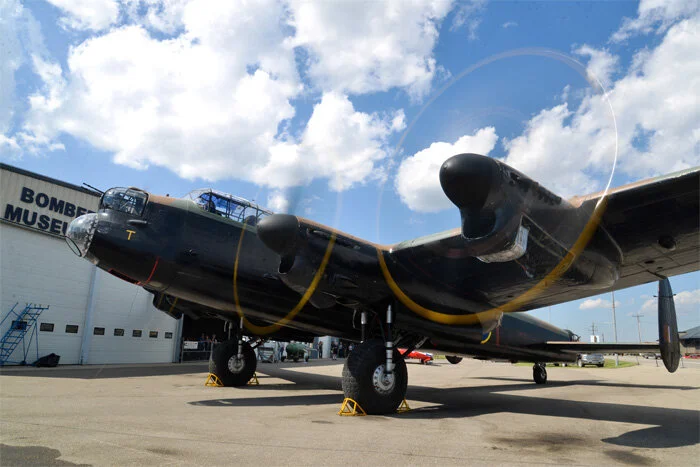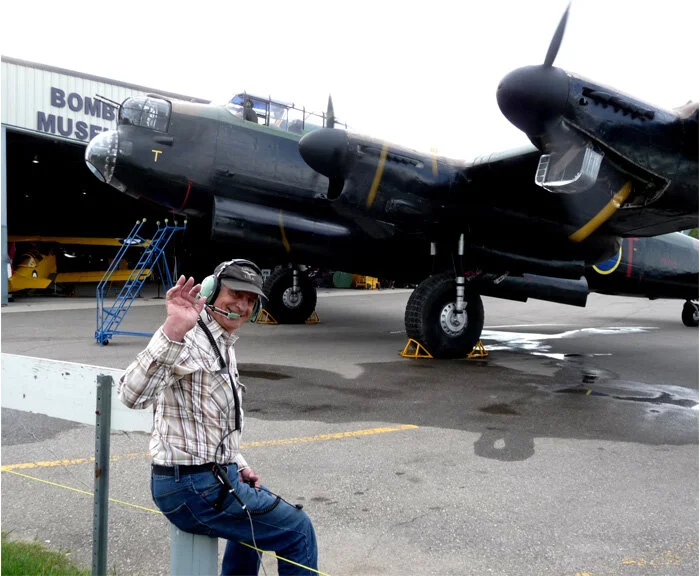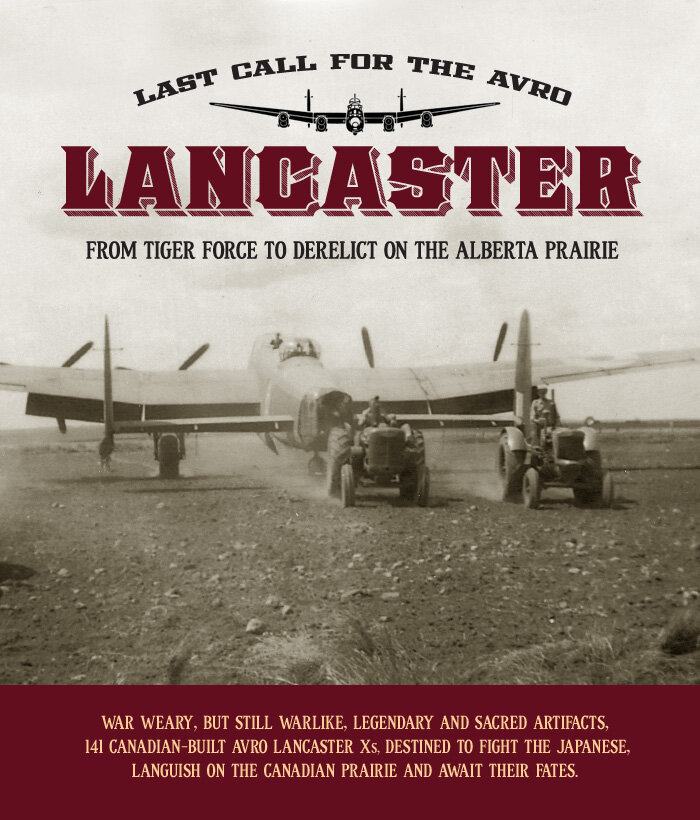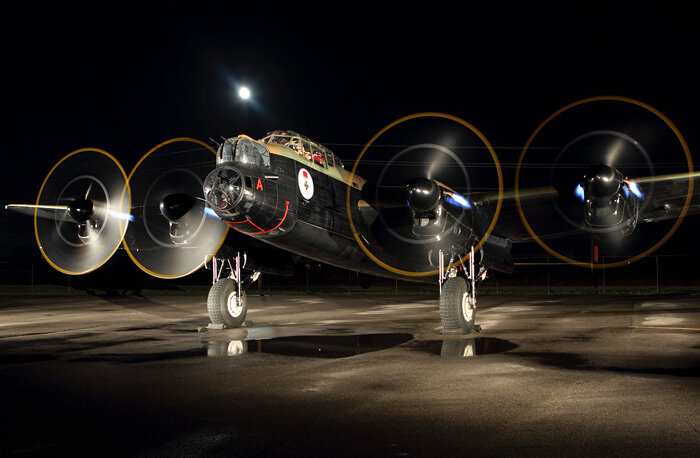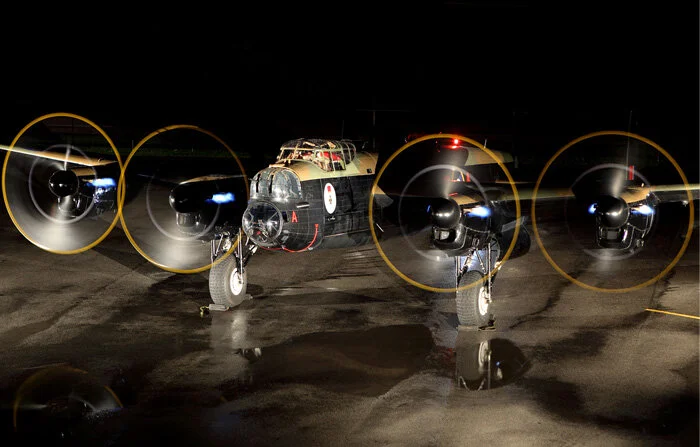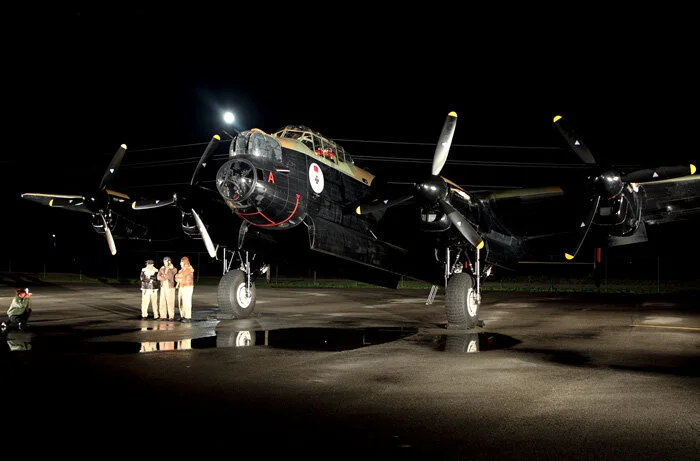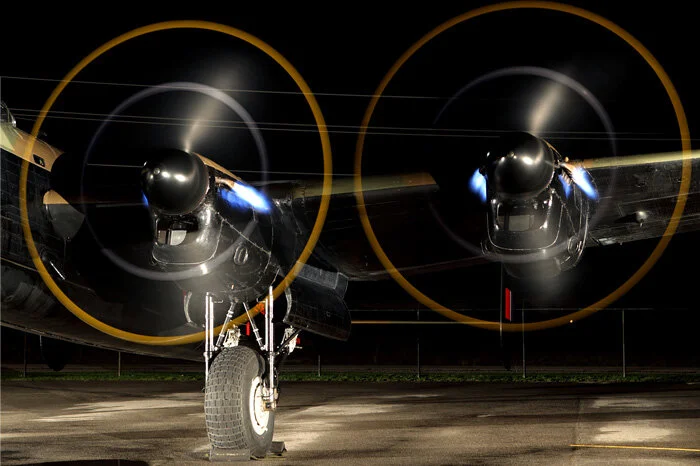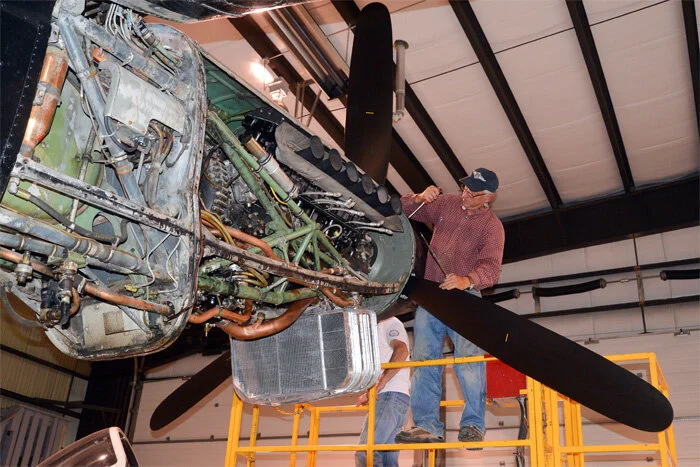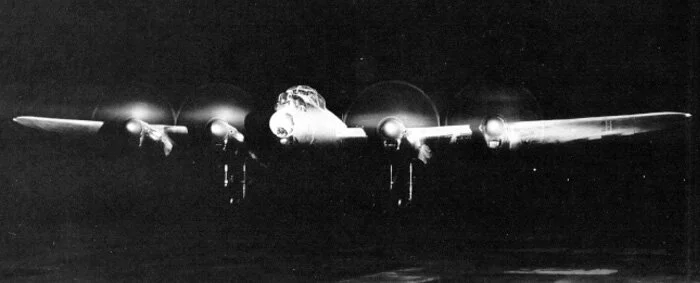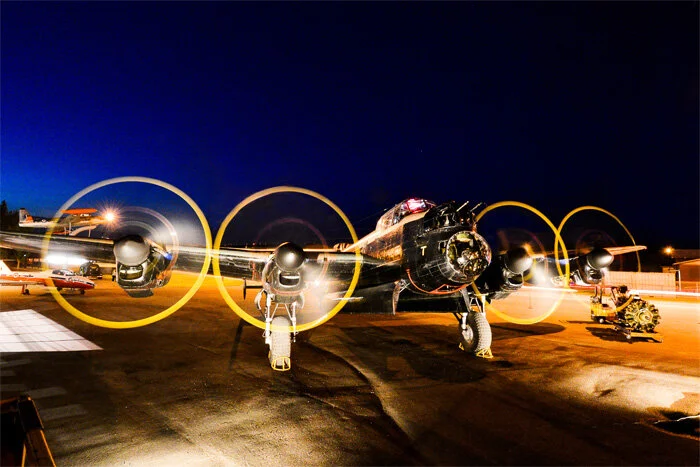THE ROAR OF FOUR
There are not many man-made objects more awe-inspiring and more emotionally and physically impacting than the sight and the sound of a Second World War Rolls-Royce Merlin engine running flat out just thirty feet from you, except maybe the sight and sound of four of them in harmonious thunder, sending blow torch blasts of blue flame from 48 exhaust stacks and spinning four massive three-bladed, variable pitch, constant speed and feathering propellers at nearly 50 revolutions per second! When all four engines are attached to the same airframe, it can only mean one thing and one thing only—an Avro Lancaster Heavy Bomber.
There are only four Lancasters in the world today that can boast all four engines running and healthy. Only two of these fly (the Canadian Warplane Heritage Museum’s Andrew Mynarski Lancaster and the RAF’s Battle of Britain Memorial Flight Lanc). The third is a fully restored and taxi-able but not yet flyable example in Lincolnshire, owned by poultry farmers Fred and Harold Panton. The fourth and latest Lancaster aircraft to join this rare breed is Lancaster FM159 of the feisty Bomber Command Museum of Canada at Nanton, Alberta.
Just a few weeks ago, on 23 August 2013, after seven years of disciplined restoration, the fourth and last Merlin engine, the port outer, roared to mighty life outside the Nanton hangar. Hallelujah! Glory be to Bomber Harris in the highest! Praise be to Saint Guy of Scampton! The mighty, avenging roar of four Merlins, with their throttles fire-walled, shook the sleepy farming town of Nanton and could be heard all the way to High River, some say Vulcan and even Okotoks!! It was the unofficial four engine run-up, a test of the engines before the big reveal coming up this weekend (20–21 September) at the Bomber Command Museum of Canada (BCMC).
The port outer Merlin engine joins the chorus for the first time and the Bomber Command Museum of Canada’s Lancaster is firing on all 48 cylinders!! Photo: Bomber Command Museum of Canada; Doug Bowman
There were high-fives and smiles all around as the dedicated team of volunteer technicians responsible for the milestone looked on. Led by gifted engineer, 85-year-old John Phillips, the team, comprised of Greg Morrison, Shane Chipchase, Francis Gardner, Brian Taylor, Fred Hollowell and Merill Honeyman and others, worked through many long days and nights. The daunting task of coaxing the sweet melody of 12 cylinders out of each Merlin began more than seven years ago, under the direction of Phillips who, because of his wisdom and serenity, is lovingly known as Yoda by BCMC staff and volunteers, and the result was a symphony of thunderous and odorous internal combustion and the swirling, shimmering sight of four yellow-ringed discs of propellers.
Eighty-five-year-old John Phillips (I know, it’s hard to believe) revels in the glorious sound of all four engines in harmony. Phillips led the team that restored and brought to life all four engines over a seven year period. Photo: Bomber Command Museum of Canada; Doug Bowman
Later that evening, the BCMC volunteers ran a test on a night run of the four engines, a precursor of a planned night run on the Lanc’s big debut this weekend. The beautiful Lancaster, restored with love, passion and determination, is now ready for her close-up.
This coming weekend, Friday, 20 September, and Saturday, 21 September 2013, the Bomber Command Museum of Canada will present to the public at large the sights, sounds, smells and chest-pounding thunder of a Victory Aircraft–built Canadian Avro Lancaster with four mighty Merlins singing the song of Victory! Vintage Wings of Canada encourages any of our readers from Alberta and even BC and Saskatchewan to get in their cars and get to Nanton this Friday for a rare nighttime photo opportunity—the photographing of a Lancaster at night. The museum will open its doors from 1900 to 2130 hours to accommodate visitors and the magic night run of the Merlins at 2030 hours.
One of the most compelling, remarkable and profoundly haunting soundtracks will be played in the darkness before the start of the first of the four Merlins. Over the loudspeakers will come the famous soundtrack called The Nightingale and the Bomber Stream. In the 1920s, the famous English cellist Beatrice Harrison was practicing in a wood/garden when a nightingale joined in a duet. This happened frequently so she got the idea to arrange to have the nightingale’s song broadcast on the radio. This continued as an annual event for around 20 years. During the 19 May 1942 broadcast, as BBC staff prepared to transmit the melodious and happy song of nightingales, 197 bombers (105 Wellingtons, 31 Stirlings, 29 Halifaxes, 15 Hampdens, 13 Lancasters, and 4 Manchesters), on their way to raid Mannheim, Germany, flew overhead. A quick-thinking engineer, realizing a live broadcast of the bombers could warn Nazi spies of the impending attack, pulled the plug. A performance of a nightingale singing to the drone of bombers flying overhead was recorded and still exists and will be played for all to enjoy. It will stand the hairs on the back of your neck. Here is a link for you to play... turn out the lights, turn up the sound and imagine the 74 young men in those aircraft who did not come back (four Halifaxes, four Stirlings and three Wellingtons failed to return). You are listening to the sound of those young men on the way to their deaths.
On Saturday, the museum is open from 0900 to 1700 hours and the day’s activities will include a special celebration at 1100, another daytime run of the four Merlins at noon and another at 1400 hours. The last run will also include a single Bristol Hercules engine run-up. This mighty radial is destined to be part of a Herculean symphony of four in the years and decades ahead...Donations and material support is always welcome.
Related Stories
Click on image
September 23rd 2013, after the event
By all accounts, the event at Nanton this past weekend was a huge success. We got this wonderful description of the event from former RCAF and Air Canada pilot Jim Griffiths:
Another great Vintage Wings article, “The Roar of the Four”
As we are now living in Alberta my wife and I took a trip down to Nanton to see and hear the roar of the mighty four. It was a beautiful day with a stereotypical bit of a Chinook blowing. The upside was that it was much warmer than normal with the signature arch well to the east guaranteeing absolutely clear and sunny conditions; perfect for photography. Unfortunately I’d left my camera at home a sure sign of advancing age. We were lucky enough to garner the last remaining handicap parking spot which meant my wife had a bird’s eye view of the whole event from thirty feet away so she could sit in the comfort of the car rather than sitting on her walker.
Just as the commentator said the Bristol Hercules was indeed like a Harley on steroids. I was standing not ten feet from the prop-less engine when they fired it up. It was a good idea to run the Herc first to enhance the dramatic effect of later, the four Merlins. I felt the percussive vibrations the crackling monster gave off within my chest much like when I stood beside the runway at Oshkosh when the Concorde took off but on a smaller scale. I hoped that no stray sympathetic resonances would dither my pacemaker. The commentator had initially announced that the engine would be run at idle and the length of the performance would be governed by the cylinder head temperature. In the event the throttle was advanced to what I’m guessing was about one third of max rpm and they ran it for a good five minutes.
The centre stage highlight of course was the start-up of the four Merlins. I was standing facing the port outer engine so the fuselage blocked my view of the starboard engines. The normal 3-4-2-1 sequence was followed and after some hesitant sputtering number three finally settled into the sweet sounding throaty idle so typical of a starting Merlin. Numbers 4-2 and 1 lit up a little more smoothly. After idling for a few minutes the engines were advanced to about cruise setting for the remainder of the time till shutdown. I had an excellent view of the port exhaust stacks on numbers 1 and 2 and noticed intermittent puffs of smoke from the third and fifth stack on both engines and I can’t be sure whether I actually heard or imagined both engines misfiring slightly.
I’m loathe to mention my piddling experience of flying a four engine Merlin aircraft compared to the heroic exploits of Bomber Command crews. In any case it brought back memories of flying North Stars for TCA when I was a nimrod 21 year-old First Officer. In fact I vividly remember spending an extra night in Sydney Nova Scotia because of a backfire in one of the engines during run up. If my memory is correct as I’ve already alluded to in the first paragraph how unreliable it is, the culprit was number 3 and the maintenance check for a backfire was 12 man hours. That, a few precautionary shut downs and a runaway prop were the only excitement I ever experienced with mighty Merlins, the lasting legacy of which is my partial hearing loss...or so my wife says.
Unfortunately there is no airfield at Nanton but what the museum is hoping for is to do what another Lancaster is doing in UK, namely taxi it around on the ground on a taxi way they hope to build adjacent to a new proposed hangar. As I watched the people in the crowd I could tell they were really impressed even emotional with something that for a couple of years I took for granted...the husky bass rumbling of a 4 merlin quartet singing in unison.
The commentator for the all too short afternoon did an excellent job of narrating the event. The hosts of the Nanton museum have done a fine job considering the miserly support from the federal government compared to that of Alberta. If the commentator’s figures are accurate then the federal heritage minister ought to be ashamed. This group of dedicated enthusiasts have done what Albertans and the other westerners have always done...got on with the job with no whinging and whining relying on their own resources.
In any case it was a splendid afternoon. Thanks for promoting the event in Vintage wings.
Jim Griffith
After the fact. One of Canada's premier aviation photographers is Parr Yonemoto. The man is everywhere. He was at Wings over Gatineau-Ottawa one day and then across the country in Nanton the next weekend for the Running of the Merlins. Here we see exactly why this event and in fact all night runs are favourites with professional photographers. Photo: Parr Yonemoto
Yonemoto shoots another from an elevated position. Note the blast of blue exhaust flame from each engine. Photo: Parr Yonemoto
Before the start-up, a few re-enactors pose for photos. Photo: Parr Yonemoto
Close up of the two port engines belching blue flames. Photo: Parr Yonemoto
Lancaster FM159
Lancaster FM159 was built by Canada’s Victory Aircraft in Malton, Ontario and flown to the United Kingdom in 1945, but arrived too late to be of use to the winding down war effort. It was then returned to Canada and put into storage. Soon it saw a new life with the postwar Royal Canadian Air Force in long-range recce missions on both of Canada’s coasts. In 1959, she was flown to High River, Alberta and put into storage. Here, being prepared for scrapping, she had her four engines and propellers removed.
Three residents of Nanton (George White, Howie Armstrong and Fred Garratt), with forethought and a desire to honour the veterans of the war, purchased the remains of FM159 for just $513.00 and prepared to tow her the entire distance to Nanton (some 28 km). The Lancaster’s main wheels were too far apart to permit travelling along the roads. So the Nanton volunteers waited until the crops were all harvested, put the tail wheel in the back of a truck, and towed the bomber backwards across the fields. Two fencing crews were organized, one to take down the barbed wire fences ahead of the aircraft and a second to put them back up again. One of the more interesting challenges was easing the aircraft down the banks of the Little Bow River, through the ford, and up the other side.
Lancaster FM159 (left) at the time of her purchase by the Nanton group and a photo of her being towed across the Little Bow River after harvest time. Photos via Bomber Command Museum of Canada
What follows is a brief history of the Lancaster from the BCMC website:
When FM159 arrived in Nanton it was complete and could have flown had the engines and propellers not been removed. Two years later it was a gutted shell, thieves having removed the instruments and interior equipment and vandals having broken the cockpit, turrets, and bomb-aimers Perspex, and torn the fabric of the control surfaces. The aircraft was on the edge of town at the time and despite efforts by Fred Garratt and others, there was no stopping the vandalism.
In 1962, volunteers began to put FM159 back on the road to recovery from its sorry state. Engines and propellers were purchased and installed. The aircraft was placed on steel mounts, its tail high in the air to limit access. Fortunately, those in charge took the time to ensure that the aircraft would not be damaged. Steel mounts were fabricated and the aircraft continued to rest on its landing gear.
Harry Dwelle fabricated aluminum “windows” to cover the broken Perspex. This was most important as bird droppings cause rapid corrosion in an aluminium airplane. Ray McMahon, together with his family and friends, repaired the exterior as much as possible and painted the aircraft.
The trio that purchased FM159 then donated the aircraft to the Town. Over the following twenty years, volunteers and service clubs did what they could to keep FM159 looking its best as millions of people drove by on Highway No. 2 and the “Nanton Bomber” became a symbol for the Town.
During the 1980’s, interest from outside Nanton was being shown. Offers to acquire the aircraft had been received from several individuals and even from her previous owners at Comox. However, the Town rejected these advances and, in 1985, looked again to George White for leadership, asking him to see if he could form an organization to “take care of the bomber.”
George wrote an article in the Nanton News asking if anyone was interested in helping. He was overwhelmed with the response and the Nanton Lancaster Society was formed. At this time, no one had been in the aircraft for twenty-five years and virtually no one in Nanton knew anything about Lancasters in general, or FM159 in particular. But soon, related artifacts were on display and Lancaster T-shirts and caps were for sale in the local tourist information booth. The Society had also made the decision that the best way to “take care of the bomber” was to restore it to its wartime configuration as the centrepiece of an air museum—a rather ambitious undertaking for a community of fewer than 2,000 people. “Open Bomber Days” were held, featuring tours through FM159. These were most successful with long lines forming at the ladder leading to the cockpit. The aircraft’s role in the education of future generations had begun.
In 1991, through the co-operation of the three levels of government, Legion Branches, corporations, and thousands of individuals, a museum building was completed. On a bright Saturday morning, FM159 was rolling again, this time towed by a farm tractor into her new home.
At Nanton, the Merlin engine crew work on the Lanc’s port inner engine to get her ready for the big debut. Photo: Bomber Command Museum of Canada; Doug Bowman
The last engine in the symphony gets some TLC. Photo: Bomber Command Museum of Canada; Doug Bowman
This will be your chance to photographically recreate a scene similar to this one of a Lancaster. Photo via Bomber Command Museum of Canada
The end result will be a photo that everyone will comment on... a full colour “painting” of a Lancaster warming up for a night mission over Germany. Photo: Bomber Command Museum of Canada; Doug Bowman



